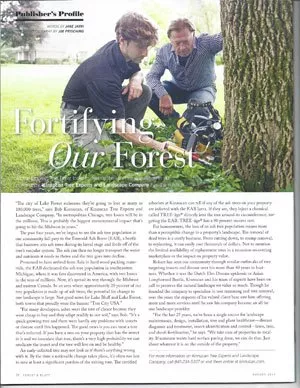Fortifying Our Forest
 “The city of Lake Forest estimates they’re going to lose as many as 100,000 trees,” says Bob Kinnucan, of Kinnucan Tree Experts and Landscape Company. “In metropolitan Chicago, tree losses will be in the millions. This is probably the biggest environmental impact that’s going to hit the Midwest in years.”
“The city of Lake Forest estimates they’re going to lose as many as 100,000 trees,” says Bob Kinnucan, of Kinnucan Tree Experts and Landscape Company. “In metropolitan Chicago, tree losses will be in the millions. This is probably the biggest environmental impact that’s going to hit the Midwest in years.”
The past four years, we’ve begun to see the ash tree population in our community fall prey to the Emerald Ash Borer (EAB), a beetle that burrows into ash trees during its larval stage and feeds off of the tree’s vascular system. The ash can then no longer transport the water and nutrients it needs to thrive and the tree goes into decline.
Presumed to have arrived from Asia in hard wood packing materials, the EAB decimated the ash tree population in southeastern Michigan, where it was first discovered in America, with tree losses in the tens of millions. Now, it’s spread its way through the Midwest and eastern Canada. In an area where approximately 20 percent of our tree population is made up of ash trees, the potential for change to our landscape is large. Not good news for Lake Bluff and Lake Forest, both towns that proudly wear the banner “Tree City USA.”
“For many developers, ashes where the tree of choice because they were cheap to buy and they adapt readily to our soil” says Bob. “It’s a quick growing tree and there were hardly any problems with insects or disease until this happened. The good news is you can treat a tree that’s infected. If you have a tree on your property that has the insect in it and we inoculate that tree, there’s a very high probability we can eradicate the insect and the tree will live on and be healthy.”
An early-infected tree may not look as if there ‘s anything wrong with it. By the time a noticeable change takes place, it’s often too late to save at least a significant portion of the exiting tree. The certified arborists at Kinnucan can tell if nay of the ash trees on your property are infected with the EAB larva. If they are, they inject a chemical called TREE-age directly into the gree around its circumference, targeting the EAB. Tree-age has a 90 percent success rate.
For homeowners, the loss of an ash tree population means more than a perceptible change to a property’s landscape. The removal of dead trees is a costly business. From cutting down, to stump removal, to replanting, it can easily cost thousands of dollars. Not to mention the limited availability of replacement trees in a recession-recovering marketplace or the impact on property value.
Robert has seen our community through similar outbreaks of tree targeting insects and disease over his more than 40 years in business. Whether it was the Dutch Elm Disease epidemic or Asian Longhorned Beetle, Kinnucan and his team of experts have been on call to preserve the natural landscape we value so much. Through he founded the company to specialize in tree trimming and tree removal, over the years the requests of his valued client base saw him offering more and more services until he saw his company become an all-in-one landscape provider.
“For the last 25 years, we’ve been a single source for landscape maintenance, design, installation, tree and plant healthcare – disease diagnosis and treatment, insect identification and control – lawn, tree, and shrub fertilization,” he says. “We take care of properties in totality. If someone wants hard surface paving done, we can do that. Just about whatever it is on the outside of the property.
For more information on Kinnucan Tree Experts and Landscape Company call 847-234-5327 or visit them online at kinnucan.com.
